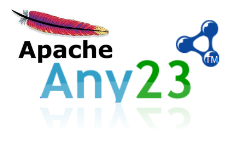Microformat Extractors
This section describes some extractions corner-cases and their relative RDF representations. Main aim of this section is to describe how some specific cases are processed with Apache Any23 showing the correspondences between the extracted RDF triples.
microformat-nesting * Nesting different Microformats
This section describes how Apache Any23 represents, with RDF, the content of an HTML fragments containing different nested Microformats. Apache Any23 performs the extraction executing different extractors for every supported Microformat on a input HTML page. There are two different possibilities to write extractors able to produce a set of RDF triples that coherently represents this nesting.
More specifically:
- Embedding explicitly the logic within the Microformats Extractors
- Using the default Apache Any23 nesting feature.
In the first case, the logic for representing the nested values, is directly embedded in the upper-level Extractor. For example, the following HTML fragment shows an hCard that contains an hAddress Microformat.
<span class="vcard">
<span class="fn">L'Amourita Pizza</span>
Located at
<span class="adr">
<span class="street-address">123 Main St</span>,
<span class="locality">Albequerque</span>,
<span class="region">NM</span>.
</span>
<a href="http://pizza.example.com" class="url">http://pizza.example.com</a>
</span>Since, as shown below, the HCardExtractor contains the code to handle nested hAddress,
foundSomething |= addSubMicroformat("adr", card, VCARD.adr);
...
private boolean addSubMicroformat(String className, Resource resource, IRI property) {
List<Node> nodes = fragment.findAllByClassName(className);
if (nodes.isEmpty()) return false;
for (Node node : nodes) {
addBNodeProperty(
getDescription().getExtractorName(),
node,
resource, property, getBlankNodeFor(node)
);
}
return true;
}
it explicitly produces the triples claiming the native nesting relationship:
<rdf:Description rdf:nodeID="nodee2296b803cbf5c7953614ce9998c4083"> <vcard:url rdf:resource="http://pizza.example.com"/> <vcard:adr rdf:nodeID="nodea8badeafb65268ab3269455dd5377a5e"/> <rdf:type rdf:resource="http://www.w3.org/2006/vcard/ns#VCard"/> <rdf:Description rdf:nodeID="nodea8badeafb65268ab3269455dd5377a5e"> <rdf:type rdf:resource="http://www.w3.org/2006/vcard/ns#Address"/> <vcard:street-address>123 Main St</vcard:street-address> <vcard:locality>Albequerque</vcard:locality> <vcard:region>NM</vcard:region> </rdf:Description>
It is higly recommended to decorate the extractors who natively handle the nesting relatioship using the @Includes annotation. This annotation, if present, avoid the production of nesting_original and nesting_structured RDF statements.
The following example shows how the @Includes annotation could be used to claim the fact that HCardExtractor natively embedds the AdrExtractor.
@Includes( extractors = AdrExtractor.class )
public class HCardExtractor extends EntityBasedMicroformatExtractor {
// code omitted for brevity
}Instead, the second manner is to leave to Apache Any23 the responsibility of identifying nested Microformats and produce a set of descriptive RDF triples. More specifically, the following HTML fragment, provided as a reference example on the Google Webmaster tools blog, shows a vEvent Microformat with a nested vCard.
<p class="schedule vevent">
<span class="summary">
<span style="font-weight:bold; color: #3E4876;">
This event is organized by
<span class="vcard">
<a class="url fn" href="http://tantek.com/">Tantek Celik</a>
<span class="org">Technorati</span>
</span>
</span>
<a href="/cs/web2005/view/e_spkr/1852">Tantek Celik</a>
</span>
</p>Due to the fact that the Apache Any23 provided extractors don't explicitly foresee the possibility of nesting such two Microformats, it automatically identifies the nesting relationship and represents it with the following triples:
<rdf:Description rdf:nodeID="node755b2b367973b6854ec68c77bec9b3"> <nesting_original xmlns="http://vocab.sindice.net/" rdf:resource="http://www.w3.org/2002/12/cal/icaltzd#summary"/> <nesting_structured xmlns="http://vocab.sindice.net/" rdf:nodeID="node985d8f2b9afb02eeddf2e72b5eeb74"/> </rdf:Description> <rdf:Description rdf:nodeID="node150ldsavbx29"> <nesting xmlns="http://vocab.sindice.net/" rdf:nodeID="node755b2b367973b6854ec68c77bec9b3"/> </rdf:Description>
That informally means that the vEvent Microformat has a nested hCard through the property http://www.w3.org/2002/12/cal/icaltzd#summary providing for them two blank nodes.



